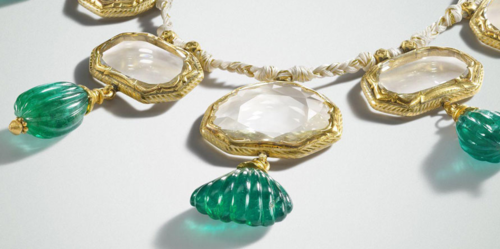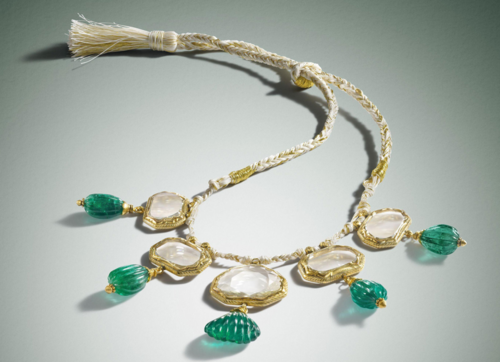'Mirror Diamond' Necklace From The Mughal Empire Priced At $20 Million
By: Kelly York
A "Mirror Diamond" necklace bearing five table-cut Mughal-empire diamonds from the early 17th century has been offered for private sale at a price of $20 million by the London auction house Bonhams.
The necklace is considered one of the most important and valuable pieces of Mughal jewelry ever seen on the market and reflects a period when the Mughals controlled most of the Indian subcontinent.
 At 28 carats, the central stone is the largest mirror or table-cut diamond in existence, and the five diamonds (ranging from 16 to 28 carats) are the largest known matching set of table-cut diamonds from the Mughal 17th century. It is most likely that the diamonds belonged to a Mughal emperor.
To both Mughal emperors and Indian maharajas, the quality and size of the gem were of paramount importance. Because gem cutters worked toward achieving the largest size possible, they typically removed only cracks and inclusions. The cutting strategies of that era often resulted in gems with irregular and asymmetrical shapes.
At 28 carats, the central stone is the largest mirror or table-cut diamond in existence, and the five diamonds (ranging from 16 to 28 carats) are the largest known matching set of table-cut diamonds from the Mughal 17th century. It is most likely that the diamonds belonged to a Mughal emperor.
To both Mughal emperors and Indian maharajas, the quality and size of the gem were of paramount importance. Because gem cutters worked toward achieving the largest size possible, they typically removed only cracks and inclusions. The cutting strategies of that era often resulted in gems with irregular and asymmetrical shapes.
 The five table-cut diamonds featured in the necklace have a flat top and bottom, with facets around the edge. This faceting acts as a border around the irregular shape of the diamond and produces a refractive brilliance. The Gemological Institute of America has speculated that the five near colorless diamonds were cut from the same crystal.
In the necklace's current form, each diamond is encased in delicate gold frames adorned with Colombian emerald drops. The whole thing is woven in a gold and ivory silk cord. Bonhams reported that the emeralds were likely added during the late 18th or early 19th century.
It is very rare and remarkable that the Mughal Mirror Diamond necklace has survived with its gemstones intact. Much of India's royal jewelry has been subjected to the aesthetics and new cutting techniques of the 19th and early 20th century, with gemstones often refaceted into more modern shapes.
“What makes [the table-cut diamonds] so remarkable – the rarity, if you like – is that they have not been Westernized,” explained Matthew Girling, chief executive officer of Bonhams and head of its jewelry unit.
The five table-cut diamonds featured in the necklace have a flat top and bottom, with facets around the edge. This faceting acts as a border around the irregular shape of the diamond and produces a refractive brilliance. The Gemological Institute of America has speculated that the five near colorless diamonds were cut from the same crystal.
In the necklace's current form, each diamond is encased in delicate gold frames adorned with Colombian emerald drops. The whole thing is woven in a gold and ivory silk cord. Bonhams reported that the emeralds were likely added during the late 18th or early 19th century.
It is very rare and remarkable that the Mughal Mirror Diamond necklace has survived with its gemstones intact. Much of India's royal jewelry has been subjected to the aesthetics and new cutting techniques of the 19th and early 20th century, with gemstones often refaceted into more modern shapes.
“What makes [the table-cut diamonds] so remarkable – the rarity, if you like – is that they have not been Westernized,” explained Matthew Girling, chief executive officer of Bonhams and head of its jewelry unit.
 Visit Ben David Jewelers on Facebook
Visit BenDavidJewelers.com
Find us on Pinterest
Visit Ben David Jewelers on Facebook
Visit BenDavidJewelers.com
Find us on Pinterest
 At 28 carats, the central stone is the largest mirror or table-cut diamond in existence, and the five diamonds (ranging from 16 to 28 carats) are the largest known matching set of table-cut diamonds from the Mughal 17th century. It is most likely that the diamonds belonged to a Mughal emperor.
To both Mughal emperors and Indian maharajas, the quality and size of the gem were of paramount importance. Because gem cutters worked toward achieving the largest size possible, they typically removed only cracks and inclusions. The cutting strategies of that era often resulted in gems with irregular and asymmetrical shapes.
At 28 carats, the central stone is the largest mirror or table-cut diamond in existence, and the five diamonds (ranging from 16 to 28 carats) are the largest known matching set of table-cut diamonds from the Mughal 17th century. It is most likely that the diamonds belonged to a Mughal emperor.
To both Mughal emperors and Indian maharajas, the quality and size of the gem were of paramount importance. Because gem cutters worked toward achieving the largest size possible, they typically removed only cracks and inclusions. The cutting strategies of that era often resulted in gems with irregular and asymmetrical shapes.
 The five table-cut diamonds featured in the necklace have a flat top and bottom, with facets around the edge. This faceting acts as a border around the irregular shape of the diamond and produces a refractive brilliance. The Gemological Institute of America has speculated that the five near colorless diamonds were cut from the same crystal.
In the necklace's current form, each diamond is encased in delicate gold frames adorned with Colombian emerald drops. The whole thing is woven in a gold and ivory silk cord. Bonhams reported that the emeralds were likely added during the late 18th or early 19th century.
It is very rare and remarkable that the Mughal Mirror Diamond necklace has survived with its gemstones intact. Much of India's royal jewelry has been subjected to the aesthetics and new cutting techniques of the 19th and early 20th century, with gemstones often refaceted into more modern shapes.
“What makes [the table-cut diamonds] so remarkable – the rarity, if you like – is that they have not been Westernized,” explained Matthew Girling, chief executive officer of Bonhams and head of its jewelry unit.
The five table-cut diamonds featured in the necklace have a flat top and bottom, with facets around the edge. This faceting acts as a border around the irregular shape of the diamond and produces a refractive brilliance. The Gemological Institute of America has speculated that the five near colorless diamonds were cut from the same crystal.
In the necklace's current form, each diamond is encased in delicate gold frames adorned with Colombian emerald drops. The whole thing is woven in a gold and ivory silk cord. Bonhams reported that the emeralds were likely added during the late 18th or early 19th century.
It is very rare and remarkable that the Mughal Mirror Diamond necklace has survived with its gemstones intact. Much of India's royal jewelry has been subjected to the aesthetics and new cutting techniques of the 19th and early 20th century, with gemstones often refaceted into more modern shapes.
“What makes [the table-cut diamonds] so remarkable – the rarity, if you like – is that they have not been Westernized,” explained Matthew Girling, chief executive officer of Bonhams and head of its jewelry unit.
